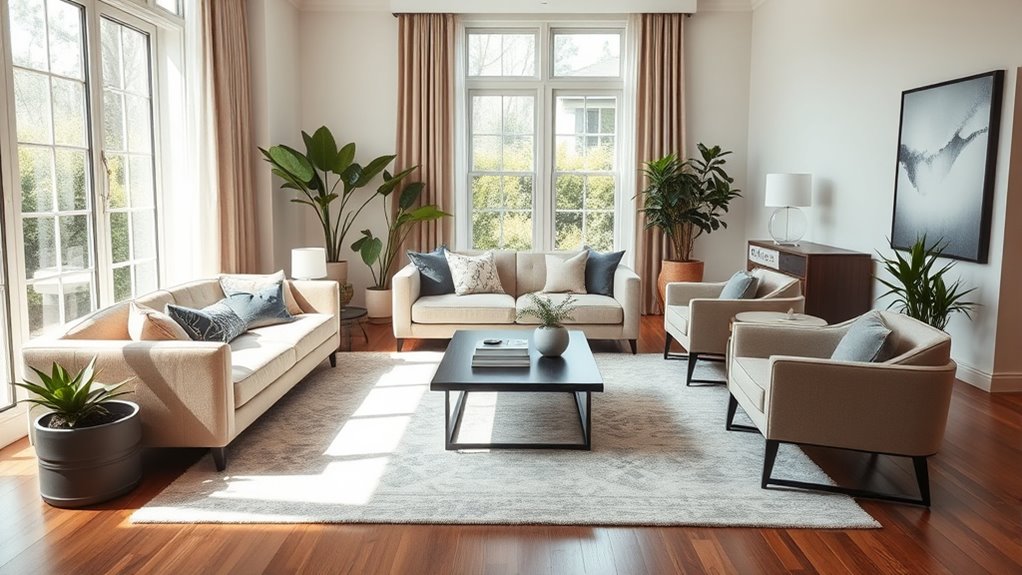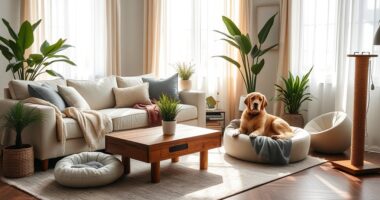To arrange furniture for better flow, start by establishing clear pathways of at least 30 inches between pieces. Position key furniture around a focal point, like a fireplace or artwork, and guarantee seating encourages conversation by facing each other within 8 feet. Use area rugs to define different zones and keep coffee tables 14 to 18 inches from sofas. Adjust layouts based on your room shape to maximize space efficiency. Keep exploring for more helpful tips on enhancing your living space.
Key Takeaways
- Maintain at least 30 inches of clearance between furniture pieces to facilitate movement and avoid congestion.
- Arrange seating to face a focal point, promoting conversation and interaction among guests.
- Use area rugs to define conversation zones and create visual cohesion within the space.
- Keep larger furniture away from high-traffic areas to ensure clear pathways throughout the room.
- Regularly assess and adjust furniture arrangements to enhance functionality and comfort in your living space.
Understanding the Importance of Furniture Arrangement

When you arrange furniture thoughtfully, you not only enhance the room's functionality but also create an inviting atmosphere.
Effective furniture arrangement establishes a clear path that improves traffic flow, allowing easy movement throughout the space. A well-planned layout can make your room feel bigger and more accessible, preventing congestion.
By strategically placing furniture around a focal point, like a fireplace or television, you encourage social interaction and create a comfortable conversation area.
Remember to maintain proper spacing—30 inches for walkways and 14 to 18 inches between coffee tables and sofas—for ideal usability.
Incorporating elements of sustainable fashion into your home decor can also contribute to a more eco-friendly living environment.
This careful arrangement not only enhances comfort but also enriches the overall experience of your living environment.
Identifying Clear Pathways for Movement
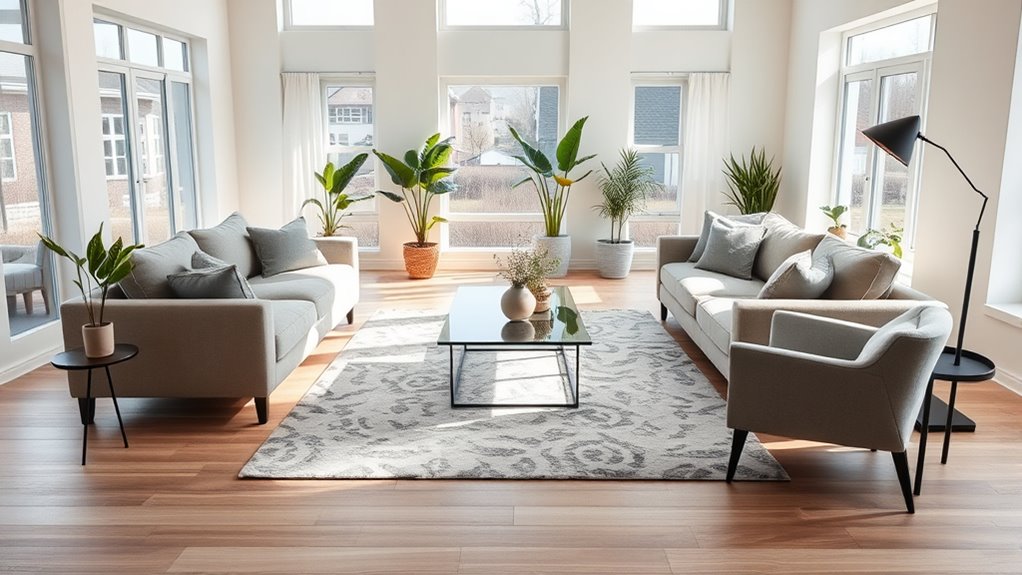
Creating a comfortable and inviting atmosphere goes hand in hand with establishing clear pathways for movement. To achieve this, maintain at least 30 inches of clearance between furniture pieces. This guarantees comfortable movement and prevents crowding in pathways. When arranging furniture, consider the flow of foot traffic and avoid placing large pieces in high-traffic areas. In larger rooms, create multiple pathways to enhance accessibility and overall flow. Regularly assess your furniture arrangements to keep pathways clear and functional.
| Tips for Clear Pathways | Description |
|---|---|
| Maintain Clearance | At least 30 inches between pieces |
| Define Routes | Create clear pathways in layouts |
| Avoid Obstructions | Keep large pieces away from paths |
| Assess Regularly | Adjust arrangements as needed |
Creating a Focal Point for Visual Interest

To create an enchanting focal point, start by positioning key furniture around a standout element like a fireplace or artwork. This not only enhances visual balance but also integrates functional decor that draws people in. Additionally, consider how lighting design can further accentuate your focal point, creating a warm and inviting atmosphere.
Establishing Centerpiece Elements
Establishing a well-defined focal point in your room not only draws the eye but also gives the space a sense of purpose.
Whether it's a striking piece of artwork, a fireplace, or a large window, your focal point enhances overall visual interest.
Arrange your seating to face this focal point, fostering interaction and making the area feel inviting.
Use a large area rug to anchor the focal point, creating a cohesive look that ties the room together.
Incorporate decorative elements like plants or accent tables around the focal point to enhance its prominence and contribute to the room's aesthetic.
Consistency in style and color reinforces a harmonious design, ensuring all elements complement each other effectively.
Enhancing Visual Balance
Once you've identified your room's focal point, enhancing visual balance becomes essential for a harmonious layout.
Arrange your furniture around this focal point, ensuring seating orientation encourages conversation and intimacy.
Symmetrical arrangements, where furniture pieces mirror each other, promote visual balance and create a cohesive look.
Use area rugs to define the space around the focal point, anchoring your furniture arrangement while adding texture and warmth.
Select decor elements that complement your focal point, like coordinating colors or textures, to achieve a unified look throughout the room.
Integrating Functional Decor
How can you turn your living space into an enchanting environment? To create a focal point, consider a fireplace or a striking piece of artwork. Position seating around this feature so that chairs and sofas face each other, promoting conversation. Add decorative elements like bold rugs or unique lighting to enhance the focal point and add depth. Incorporating natural elements into your decor can further promote tranquility and harmony in the space.
| Element | Purpose | Example |
|---|---|---|
| Focal Point | Visual Anchor | Fireplace or Artwork |
| Seating Arrangement | Encourage Interaction | Chairs facing each other |
| Decorative Elements | Enhance Interest | Unique Lighting Fixtures |
| Symmetrical Arrangements | Create Balance | Matching Side Tables |
Arranging Seating for Conversation and Comfort
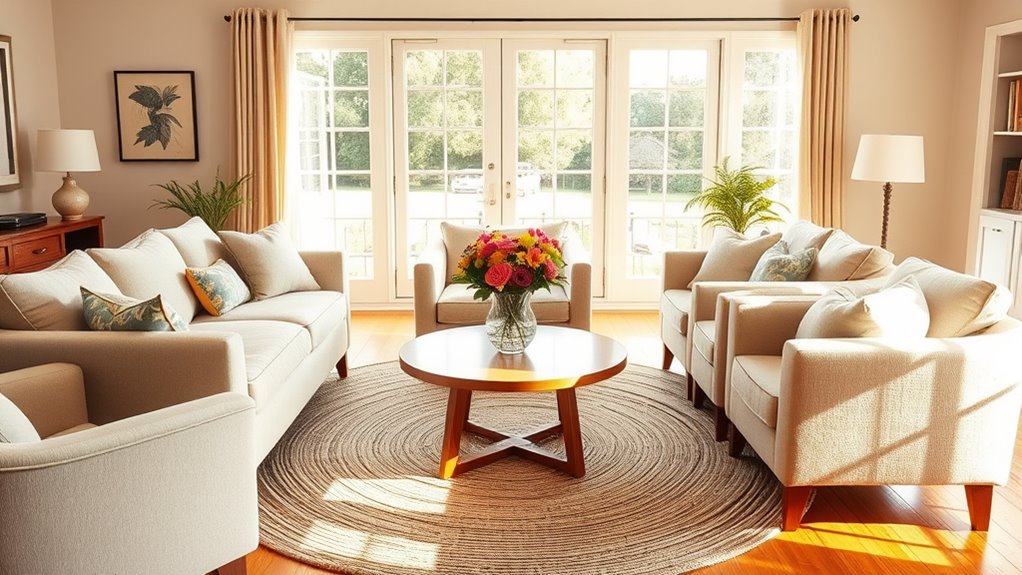
Creating an inviting seating arrangement can transform your space into a hub of conversation and comfort. Position your furniture so that sofas and chairs face each other within 8 feet, promoting easy dialogue without shouting. This layout fosters connection among guests and creates a social circle.
Incorporate side tables within arm's reach to enhance accessibility, allowing people to place drinks or personal items conveniently. Use area rugs to anchor your seating and define conversation areas, adding a cozy touch to your space.
Finally, guarantee at least 30 inches of walking space between furniture pieces to maintain a clear path, allowing for easy movement throughout the room. With these tips, you'll create a welcoming atmosphere that encourages interaction.
Maintaining Appropriate Distances Between Furniture

Maintaining appropriate distances between furniture is vital for a functional and inviting space. To create balance and enhance flow, it's important to arrange furniture with clear pathways in mind. Here are some key distances to take into account:
| Furniture Arrangement | Recommended Distance |
|---|---|
| Between furniture pieces | Minimum of 30 inches |
| Coffee table and sofa | 14 to 18 inches |
| Chairs for conversation | No more than 8 feet apart |
| Larger rooms (islands of seating) | Adequately spaced |
A common mistake is blocking natural walkways, which disrupts the room's flow and makes the space feel cramped. Prioritizing these distances guarantees comfortable use and invites interaction among guests.
Utilizing Storage Solutions for a Clutter-Free Space
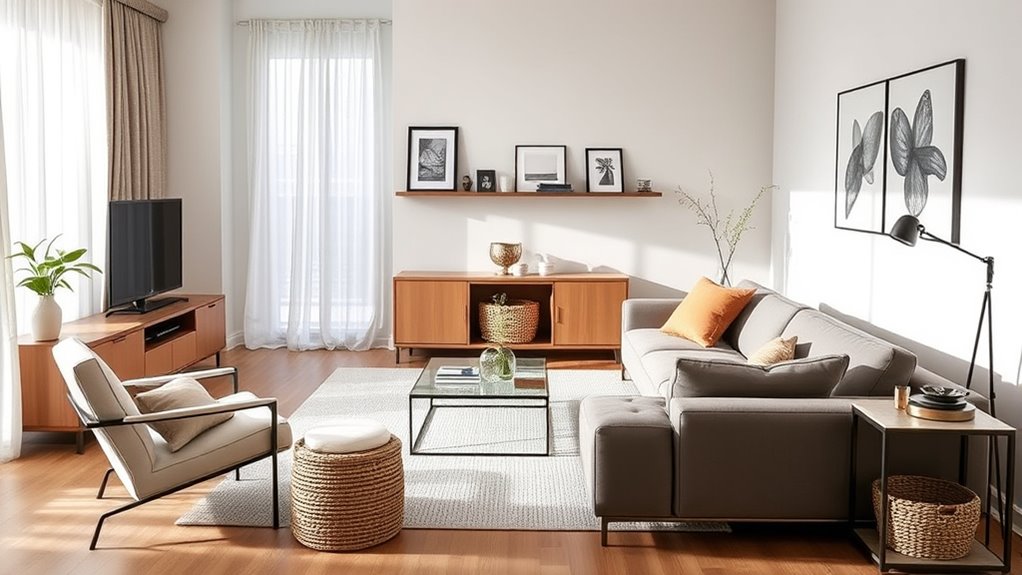
To achieve a clutter-free space, you'll want to utilize effective storage solutions that blend functionality with style.
Start by integrating multi-functional furniture, like ottomans with storage or coffee tables with drawers, to maximize utility. Built-in storage units and cabinets are perfect for stowing away books and media, helping maintain a tidy appearance.
Integrate multi-functional furniture, such as storage ottomans and drawer coffee tables, to enhance utility and keep your space tidy.
Implement drop zones near entryways with hooks and baskets to organize shoes, bags, and keys, promoting an uncluttered environment as you enter your home. For open shelving, choose decorative boxes or baskets to conceal smaller items while enhancing your decor.
Make certain that all storage solutions are easily accessible, allowing for quick organization and a streamlined flow throughout the room. Additionally, incorporating natural materials in your storage solutions can enhance the overall aesthetic while maintaining the rustic charm characteristic of modern farmhouse design.
Incorporating Lighting for Ambiance and Functionality
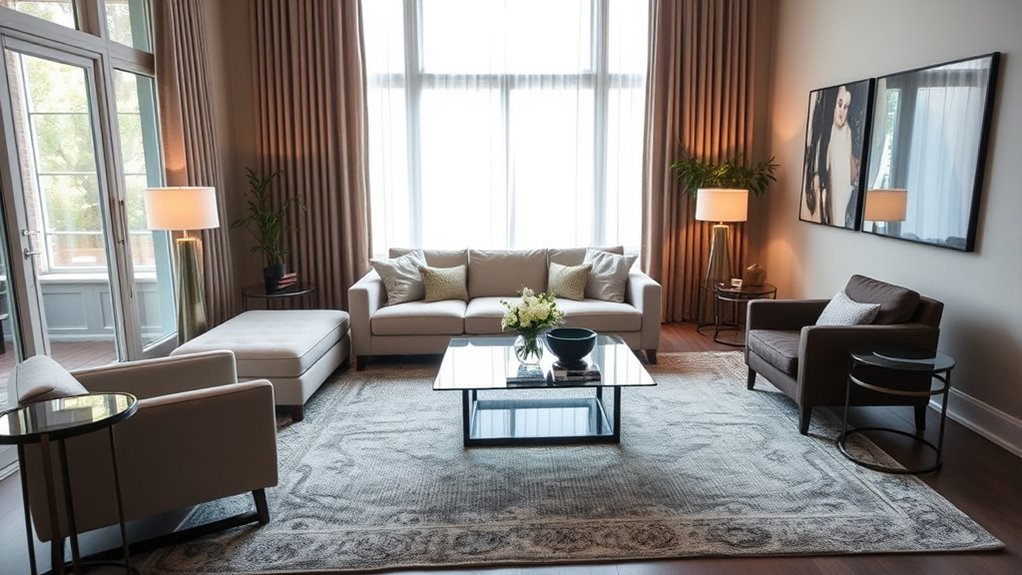
To create a welcoming atmosphere, make the most of natural light by positioning your furniture to maximize sunlight during the day. Layered lighting techniques, combining ambient, task, and accent lights, will help you achieve both functionality and a cozy vibe in the evening. Additionally, incorporating air purifiers can enhance indoor air quality, contributing to a healthier living environment.
Natural Light Utilization
While maximizing natural light in your space can markedly enhance its ambiance, arranging your furniture strategically plays an essential role in achieving this goal.
Keep large furniture pieces away from windows to let sunlight illuminate the room, creating a warm atmosphere. Position seating areas near windows to take advantage of natural light for reading and relaxation.
Use mirrors to reflect natural light into darker corners, brightening the overall space. Opt for translucent or sheer window treatments that filter light without blocking it, maintaining privacy while optimizing natural light flow.
Finally, consider your light sources; place fixtures where they complement natural light, enhancing your environment with a balanced mix of ambient and task lighting throughout the day. Additionally, implementing the four-box method during the decluttering process can help create a more open and inviting layout, allowing natural light to flow freely.
Layered Lighting Techniques
Creating the right atmosphere in your home hinges on effective lighting techniques. Layered lighting combines ambient, task, and accent lighting to craft a versatile atmosphere.
Ambient lighting, your main source of illumination, guarantees the space feels inviting and is well-lit for general activities. Task lighting focuses on specific areas—think desk lamps or under-cabinet lights—making it easier to read, cook, or work.
Accent lighting highlights features like artwork or architectural details, adding depth with spotlights or sconces. To enhance flexibility, incorporate dimmer switches, allowing you to adjust lighting levels effortlessly. This way, you can easily shift from bright, energetic settings to cozy, relaxed environments, guaranteeing your home always feels just right. Additionally, maintaining optimal performance of your air purifier through regular cleaning can improve air quality, complementing your layered lighting approach.
Adapting Arrangements for Different Room Shapes
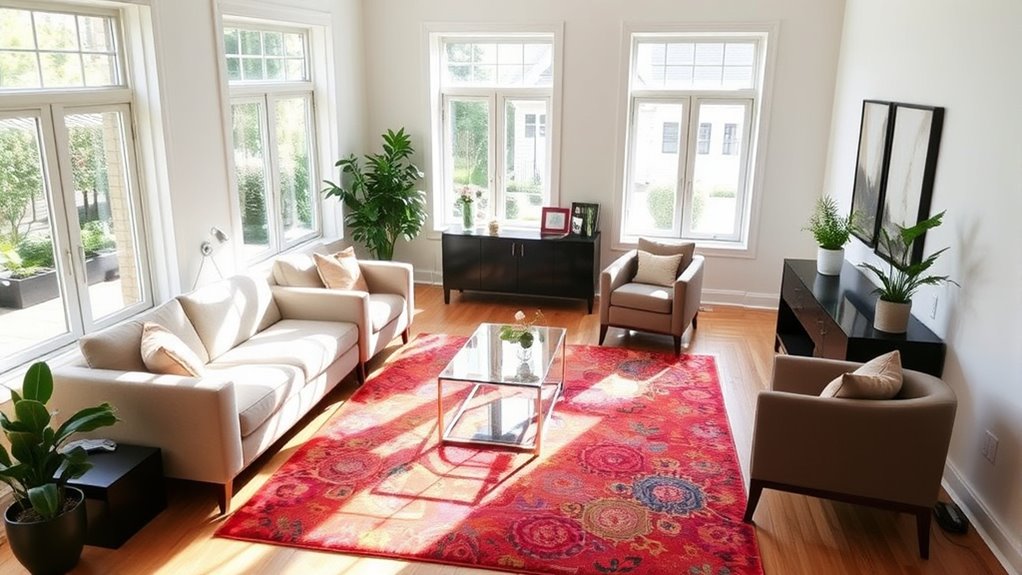
When you're arranging furniture, understanding the shape of your room can greatly enhance both function and flow. Different room layouts require unique approaches to create a clear path and promote movement. Here's a quick guide to help you adapt your arrangements:
| Room Shape | Best Arrangement | Key Tips |
|---|---|---|
| L-shaped | Separate seating and entertainment areas | Use cozy nooks for enhanced flow |
| Long and narrow | Sofa along one wall, TV opposite | Guarantees natural traffic flow |
| Square | Symmetrical around a focal point | Promotes balance and easy navigation |
In smaller or uniquely shaped spaces, choose multi-functional furniture pieces to adapt to various needs, maintaining an open feel while achieving a cohesive look. Additionally, consider using scratching posts to redirect your pets' behavior, ensuring a harmonious living space.
Maximizing Small Spaces With Smart Layouts

To make the most of small spaces, you can employ smart layouts that enhance both functionality and comfort.
Start by incorporating multi-functional furniture, like ottomans with storage or sofa beds, to maximize utility without sacrificing style.
Consider a floating furniture arrangement, pulling seating away from the walls to create a cozy seating area that encourages conversation.
Choose narrow or modular pieces that fit seamlessly into tight spaces while maintaining proportions.
Use area rugs to define different zones, giving the illusion of separate areas while keeping an open flow.
Finally, guarantee pathways of at least 30 inches between furniture to facilitate easy movement, preventing your small space from feeling cramped and enhancing its overall livability. Additionally, utilizing vertical storage solutions can further optimize your space by freeing up floor area for more functional layouts.
Experimenting With Different Arrangements for Optimal Flow
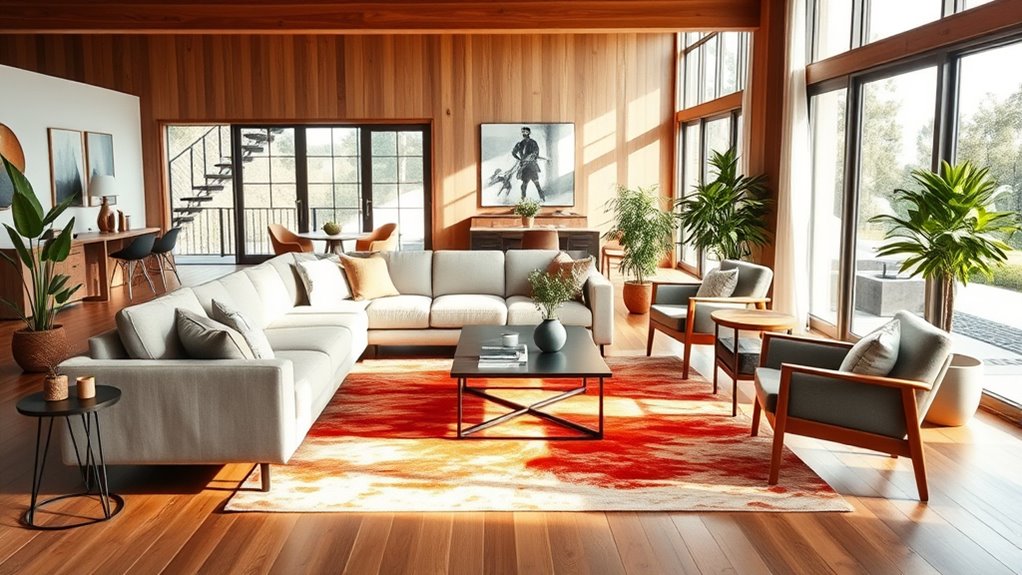
How can you discover the best furniture arrangement for your space? Start by experimenting with different layouts using online floor planners or graph paper. Visualizing your arrangement helps you see how furniture can enhance flow.
Make sure key pieces are oriented toward focal points like a fireplace or TV to foster interaction. Keep clear pathways of at least 30 inches between furniture to facilitate movement and prevent overcrowding. Consider floating furniture in the center of the room, creating an inviting conversation area.
Incorporating innovative interior design can also significantly improve the overall aesthetic and functionality of your space. After living with your setup for a week, assess its comfort and functionality. Some layouts might seem perfect initially, but small tweaks can make a big difference in achieving ideal flow. Enjoy the process of creating a comfortable space!
Frequently Asked Questions
What Is the 2/3 Rule Furniture?
The 2/3 rule in furniture arrangement suggests that you should fill about two-thirds of a room's space with furniture.
This creates a balanced and inviting atmosphere while ensuring enough open area for movement.
To apply this rule, measure your furniture and the room, adjusting your layout until you achieve that two-thirds occupancy.
What Are the Four Rules in Furniture Arrangement?
Did you know that 80% of people feel more comfortable in a well-arranged space?
When arranging furniture, focus on four key rules: prioritize traffic flow by leaving clear pathways, create conversation areas by positioning seats within eight feet of each other, achieve balance and symmetry with varied furniture sizes, and identify focal points to draw attention.
What Is the Biggest Mistake in Placement of Furniture?
The biggest mistake you can make in furniture placement is pushing all your furniture against the walls. This creates a rigid feel, limiting the room's flow and making it less inviting.
You risk overcrowding the space, which can lead to discomfort and clutter. Additionally, blocking natural light or failing to create clear pathways can hinder movement, making your room feel cramped and unwelcoming.
Aim for balance and openness to enhance your space's overall appeal.
Is There an App to Help Me Rearrange My Furniture?
Yes, there are several apps that can help you rearrange your furniture!
Apps like Roomstyler and Planner 5D let you create detailed floor plans and visualize layouts in both 2D and 3D.
If you want a quick solution, try MagicPlan, which generates floor plans from photos.
For an interactive experience, IKEA Place uses AR to show how furniture fits in your space.
With these tools, you'll find it easier to experiment with different arrangements.
Conclusion
To sum up, prioritizing purposeful placement can transform your space. By focusing on fluidity and fostering friendly interactions, you'll create a charming and cozy environment. Don't hesitate to tweak and test different layouts to find what feels right for you. Remember, a well-arranged area not only enhances aesthetics but also elevates everyday experiences. So, embrace creativity, explore options, and enjoy your beautifully balanced furniture flow! Your home deserves a delightful design that dances with dynamism.
